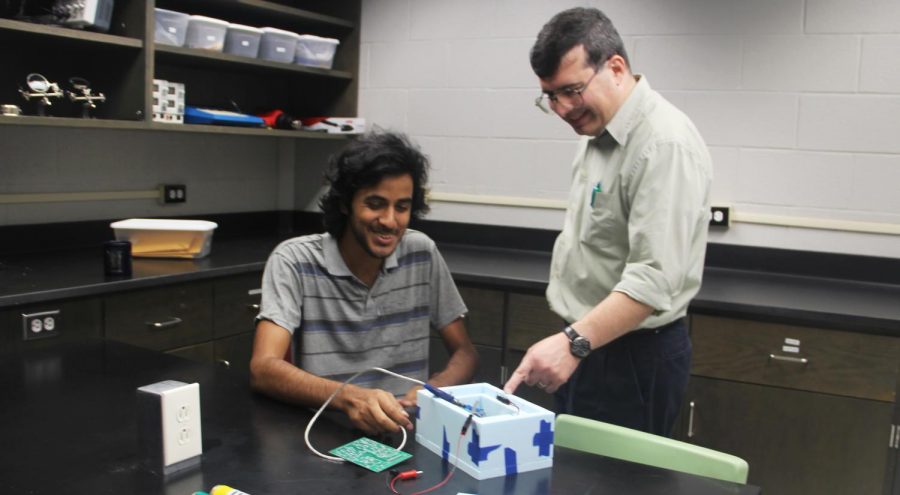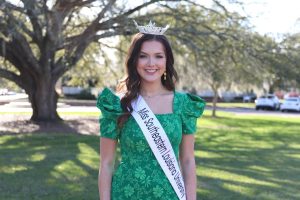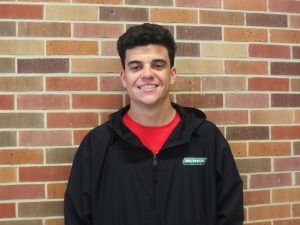Creation of a weather balloon
Maiah Woodring
Damodar Dahal, a senior majoring in mathematics, physics and computer science, and Professor of Physics Dr. Gerard Blanchard work on Project ROOMIE 1.
November 26, 2018
Professor of Physics Dr. Gerard Blanchard works with a team of four students to construct and design a fully functional weather balloon due to launch from Palestine, Texas in May of 2019.
Project ROOMIE 1, or Remote Observations Of Many Interesting Events, was funded for the first time by the Louisiana Space Grant Consortium this August. Blanchard explained that the purpose of the project is two-pronged.
“There’s many different dimensions to purpose,” said Blanchard. “The educational purpose is to give, for the physics majors, what we call a design experience. A lot of physics majors go on to become engineers. And there’s one thing that’s integrated into the engineering curriculum that’s not integrated into the physics curriculum, and that’s a design experience. So, that’s the educational goal, to give them this design experience.”
In addition to learning how to construct the balloon, Blanchard also realizes that there is another facet to the education experience.
“Part of the educational experience is that there’s a hard deadline to this,” said Blanchard. “You know, when the date for the launch is set, if the team’s not ready, they’re not going to fly. So, there’s no incompletes, no extensions, no partial credit. Either your ready on that day, or you’re not.”
Blanchard explained the scientific purpose.
“The scientific goal is for them to measure what’s called convectively available potential energy in the atmosphere,” said Blanchard. “So, the bigger that number, the stronger thunderstorms, and things like that you’re going to have. A very low number means you’re going to have a clear, still day, a little bit higher number means you’re going to have fluffy clouds, and even higher numbers means you’re going to have storm clouds and things like that.”
Blanchard explained how the students will calculate the connectively available potential energy.
“The National Weather Station in Dallas, they launch these balloons twice a day to make these measurements,” said Blanchard. “So, our students are going to recreate those measurements, and they’re going to compare it to the measurements that the professionals got on that day.”
In order for the results to be as similar as possible, Blanchard intends to launch the weather balloon with the students from Palestine, Texas, about 110 miles from Dallas.
“As it goes up, it’s going to measure temperature, pressure and humidity,” said Blanchard. “So, the balloon’s going to fly up. It’s going to go up to 100,000 feet, 20 miles high, and then they’re going to cut loose from the balloon, and everything’s going to fall back down on a parachute and come back to the ground, and then we’ll recover it.”
Blanchard mentioned some unfavorable places that the weather balloon could land, such as in a tree or river.
Blanchard said, “We still have to get it, one way or the other, and then we bring it back, and then they’ll analyze their data, and then they’ll make their final presentation to the staff at the NASA Columbia Scientific Balloon Facility. That is the end goal for the students, to make their final presentation and then they’re done.”
Damodar Dahal, a senior triple majoring in mathematics, computer science and physics, is one of the students working on Project ROOMIE 1. His task is to program the balloon satellite control board.
“The most exciting thing is that it is actually going to fly in a very high altitude,” said Dahal. “That’s almost three times the altitude that the airplanes fly at. I’m really excited.”
Blanchard plans to submit a proposal for ROOMIE 2 and is hoping to have a couple more students join him for the next time around.
Although Blanchard has not begun advertising for this opportunity yet, Dahal had some words of advice for students who may be interested next year.
“Just join,” said Dahal. “Don’t think twice and join.”









